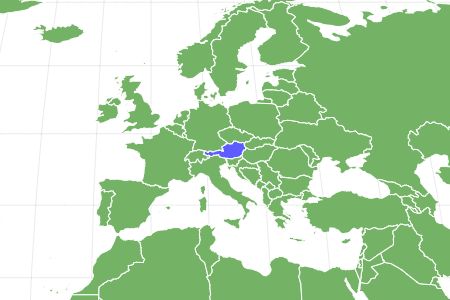Alpine Dachsbracke
Canis lupus
It’s known as a cold-nose hound because it can pick up a scent on a trail that’s gone cold.
Advertisement
Alpine Dachsbracke Scientific Classification
- Kingdom
- Animalia
- Phylum
- Chordata
- Class
- Mammalia
- Order
- Carnivora
- Family
- Canidae
- Genus
- Canis
- Scientific Name
- Canis lupus
Read our Complete Guide to Classification of Animals.
Alpine Dachsbracke Conservation Status
Alpine Dachsbracke Facts
- Fun Fact
- It’s known as a cold-nose hound because it can pick up a scent on a trail that’s gone cold.
- Distinctive Feature
- Elongated body and short, stocky legs
- Temperament
- Fearless, friendly and intelligent
- Training
- Easy
- Diet
- Omnivore
- Average Litter Size
- 8
- Type
- Scent Hound
- Common Name
- Alpine Dachsbracke
- Slogan
- Good companion and hard-working breed!
- Group
- Dog
Alpine Dachsbracke as a Pet:
- General Health
- Energy Level
- Shedability
- Trainability
- Intelligence
- Tendency to Chew
- Size
- Family and kid friendliness
- Yappiness / Barking
- Moderate
- Separation Anxiety
- Moderate
- Preferred Temperature
- Cold climate
- Exercise Needs
- Moderate
- Friendly With Other Dogs
- Moderate
- Pure bred cost to own
- $1200
- Dog group
- Hound
- Male weight
- 33-40 lbs
- Female weight
- 33-40 lbs
This post may contain affiliate links to our partners like Chewy, Amazon, and others. Purchasing through these helps us further the A-Z Animals mission to educate about the world's species.
View all of the Alpine Dachsbracke images!
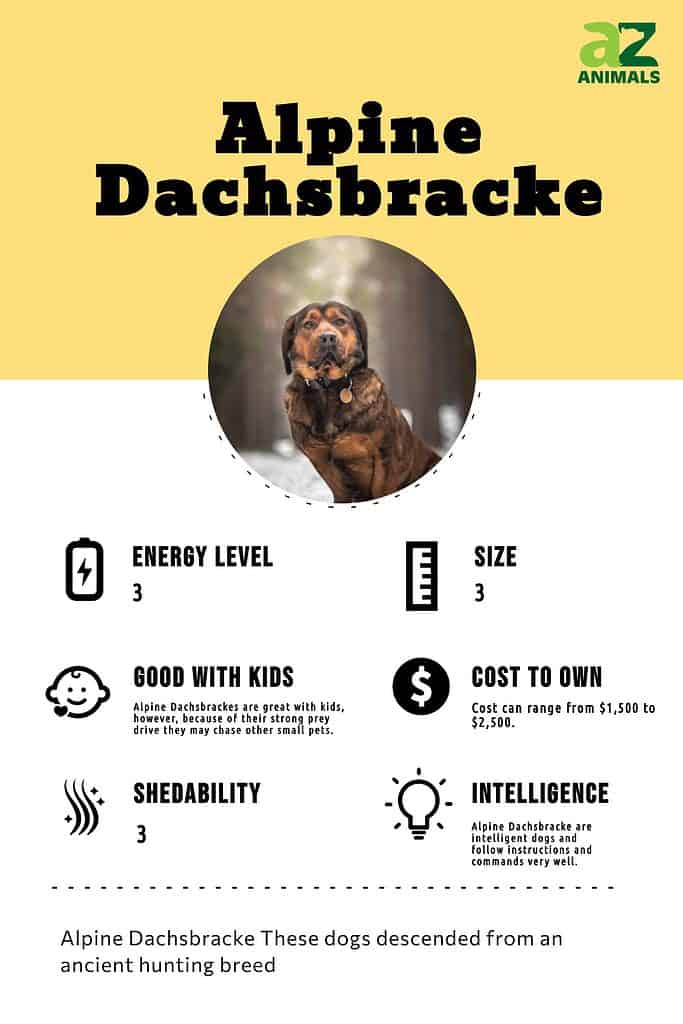
Alpine Dachsbrackes are experts at picking up scents on a trail that has gone cold.
Take one look at the Alpine Dachsbracke and you may think you’re seeing a dachshund. This breed is a mix between a dachshund and an Austrian black and tan hound.
See all of our expert product reviews.
It originated in Austria in the mid-nineteenth century. This breed was a favorite with Austrian royal families. They were bred to track down wounded deer and boar as well as track foxes and rabbits during a hunting trip. This breed belongs to the hound group.
Loyal and affectionate, a properly socialized Alpine Dachsbracke is an excellent family dog. Though it’s short in stature, this dog has a lot of energy and determination especially when it comes to following a scent.
3 Pros and Cons of Owning an Alpine Dachsbracke
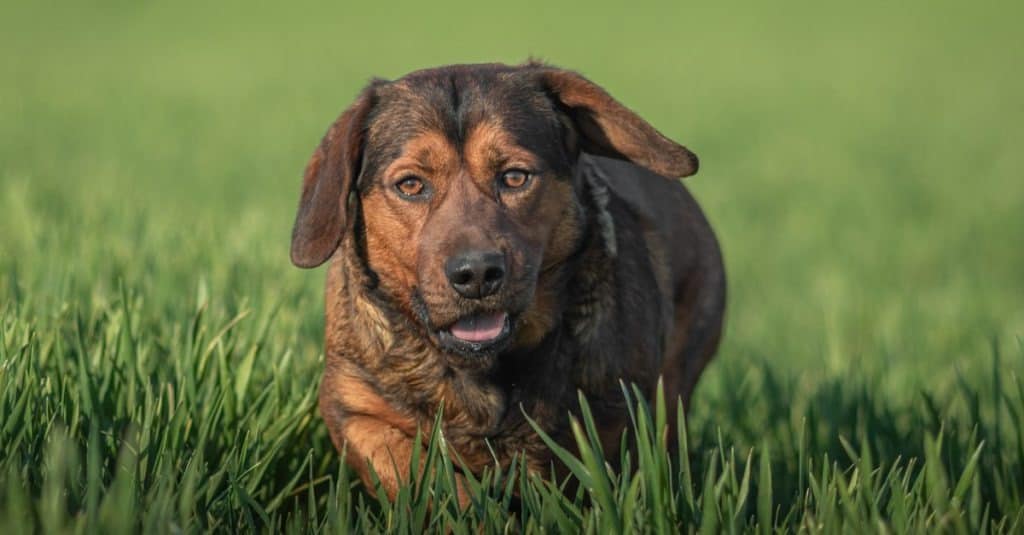
This breed is known for its intelligence making it easy to train.
©Josef_Svoboda/Shutterstock.com
| Pros! | Cons! |
|---|---|
| Easy to train This breed is known for its intelligence making it easy to train. | Scent centered This dog is a hound that can easily be distracted by an interesting scent. |
| A high degree of loyalty These dogs have a loyal nature which is part of why they are good family dogs. | Some back issues Jumping from high surfaces puts this dog at risk for back injuries. |
| Good with kids Alpine Dachsbrackes that are properly socialized from puppyhood are affectionate and good with children. | Regular exercise needed This is a high-energy dog that requires a daily exercise of 30 minutes or more. |
Size and Weight
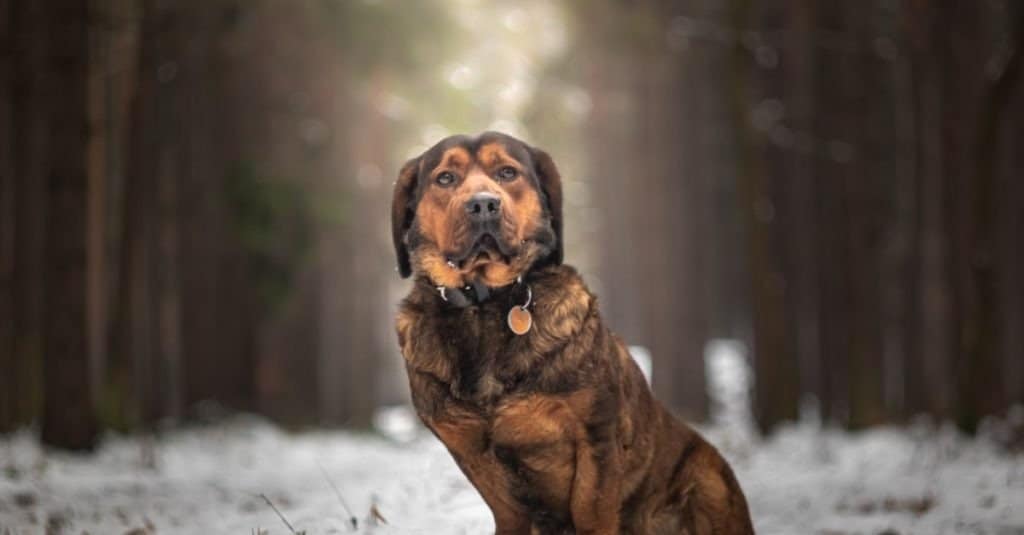
An Alpine Dachsbracke is a medium-sized dog.
Health and Entertainment for your Alpine Dachsbracke
See all of our expert product reviews.
©Josef_Svoboda/Shutterstock.com
An Alpine Dachsbracke is a medium-sized dog that can grow to be 16 inches tall at its withers. Males and females weigh up to 40 pounds fully grown. Alpine Dachsbracke puppies weigh 9 pounds at 8 weeks old and are fully grown at 2 years old.
| Height (Male) | 16 inches tall |
| Height (Female) | 16 inches tall |
| Weight (Male) | 40lbs, fully grown |
| Weight (Female) | 40lbs, fully grown |
Evolution and Origins
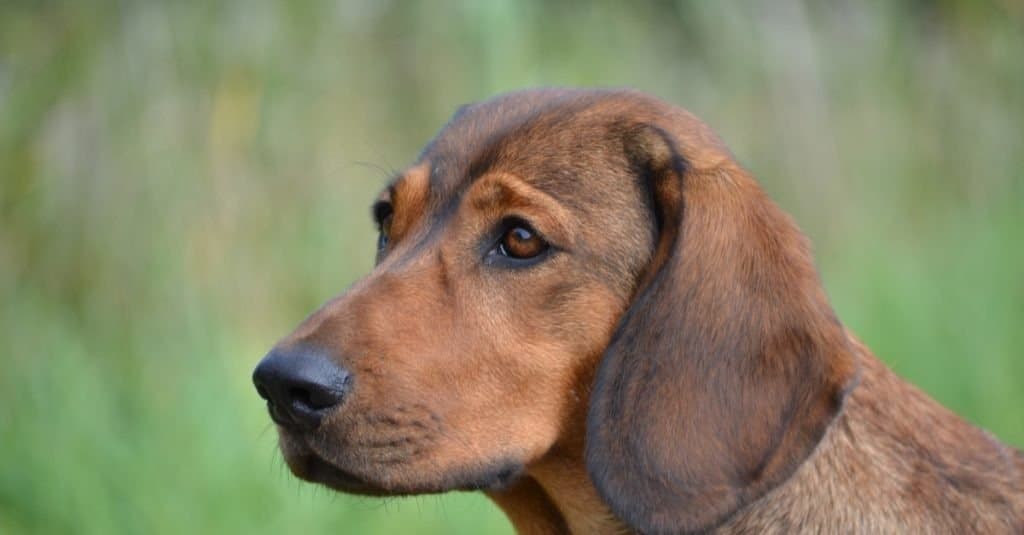
The Alpine Dachsbracke is a small, sturdy hunting dog that was developed in the alpine regions of Austria and Germany.
©Bildagentur Zoonar GmbH/Shutterstock.com
The Alpine Dachsbracke is a small, sturdy hunting dog that was developed in the alpine regions of Austria and Germany.
The breed is believed to have originated from crosses between the Dachshund and various other European hunting breeds, such as the Basset Hound, the Hanoverian Scenthound, and the Leithund.
The Alpine Dachsbracke was used primarily for hunting small game, such as hares and foxes, and was known for its ability to track scents over rough terrain.
The breed was officially recognized by the Austrian Kennel Club in 1910 and by the German Kennel Club in 1911. The breed is considered a versatile hunting dog and a good companion.
Common Health Issues

Alpine Dachsbracke during dogs show in Katowice, Poland
©Pleple2000, CC BY-SA 3.0, via Wikimedia Commons – Original / License
As with other breeds, the Alpine Dachsbracke can suffer from certain health issues. One of those issues is hip dysplasia. Hip dysplasia is the dislocation of the hip joint. Limping and limited movement are both signs of this condition. A balanced diet and weight management can help prevent this condition.
Another health issue of this breed is obesity. This dog has a long body with very short legs. So, any extra weight is going to put excess pressure on the bones in its short legs as well as on its sensitive back. Monitoring the amount of dog food given to this breed is important for preventing obesity.
A third health issue of this breed is intervertebral disc disease. This occurs when the padding between vertebral bones starts to wear away. This is especially dangerous for dogs with long backs. Preventing obesity can certainly help to prevent this condition.
The most common health issues of this dog include:
- Hip dysplasia
- Obesity
- Intervertebral disc disease
Temperament
One of the most well-known traits of an Alpine Dachsbracke dog is its determination. This dog picks up a scent and won’t let it go until the end of the trail! In addition, this breed has a loyal personality which makes it ideal as a family dog. As a note, it’s important for an Alpine Dachsbracke to be socialized. A dog that isn’t socialized can become agitated at the unexpected behavior of very young children.
Their loyal temperament also makes them great watchdogs.
The behavior of this breed is influenced by its drive to track down a scent. Once again, socialization can help to prevent this dog from wandering while curiously following the scent of another animal.
How to Take Care of Alpine Dachsbrackes
Learning as much as possible about an Alpine Dachsbracke helps an owner to give it the proper care. Giving this pet a nutritional diet that prevents common health issues can extend its lifespan. Whether someone chooses a puppy or an adult dog, factoring in the specific diet, exercise, and grooming needs of this breed can only raise the quality of care.
The Best Dog Food for Alpine Dachsbrackes
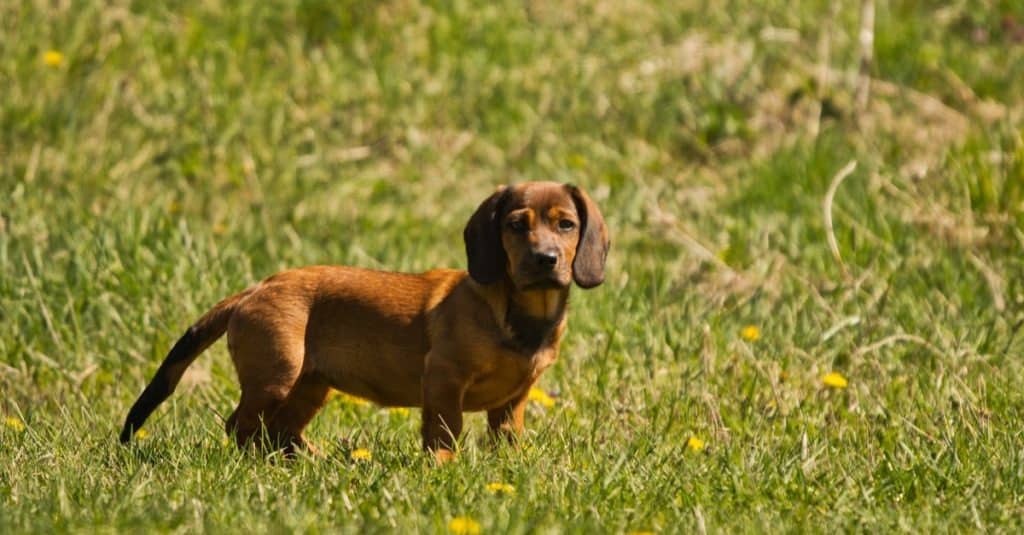
Alpine Dachsbracke puppies and adult dogs need different amounts and types of nutrients in their diet.
©Peter Vrab/Shutterstock.com
Not surprisingly, Alpine Dachsbracke puppies and adult dogs need different amounts and types of nutrients in their diet. Feeding this dog the proper diet supports its overall health and fights against common issues such as hip dysplasia and obesity. Check out a few things to factor into this dog’s diet.
Alpine Dachsbracke puppy food: Calcium is an important nutrient in this puppy’s diet. This puppy needs to develop strong bones to support its long body. In addition, having strong bones can help to prevent the development of hip dysplasia. A good balance of protein and fat is another essential in this puppy’s diet. Protein builds muscle and fat is quickly burned by this high-energy canine. Omega-6 fatty acids contribute to a healthy coat. Giving a puppy a healthy diet and monitoring its weight can prevent obesity.
Alpine Dachsbracke adult dog food: Protein in an adult Alpine Dachsbracke’s diet contributes to healthy muscles. Omega-3s support an adult dog’s immune system. A limited amount of fat provides energy to this active breed. Calcium keeps a growing dog’s bones healthy. Also, fiber helps with the digestive process in adult dogs. Once again, monitoring the amount of food given to an adult Alpine Dachsbracke can certainly prevent obesity. Dog food with real turkey meat and vegetables such as spinach or broccoli is a healthful choice.
Due to the risks to Alpine Dachsbrackes’ vertebrae and hips, maintaining a healthy weight via high-quality food is a must. So A-Z Animals recommends
This food’s EPA, glucosamine, and omega-3 fatty acids lend themselves to trusty joints that don’t quit. Your Alpine Dachsbracke will love the turkey, duck, and quail recipe bursting with protein for lean muscle.
You can buy Purina Pro Plan Sport, Energy, and Vitality Support on amazon.
Maintenance and Grooming
How much does an Alpine Dachsbracke shed? This breed of dog has a coat with two layers, so it sheds an average amount of hair.
It requires weekly grooming to get rid of loose or dead hair. A brush with soft, boar’s hair bristles helps to remove loose hair. Also, a soft slicker brush is effective at loosening and removing hair located deep in the dog’s coat. Be sure to get a slicker brush with plastic covers on the bristles. These coverings protect the dog’s skin.
The best way to brush this dog is by beginning at its head and moving in the natural direction of its coat toward its tail.
Cleaning the underside of an Alpine Dachsbracke’s ears should be a part of its grooming routine. Use a cleaning solution designed for the underside of a dog’s ears as well as a soft cloth.
One of the advantages of establishing a weekly brushing routine is an owner can readily spot any skin irritations or bald spots in a dog’s coat. These can be symptoms of an allergy.
Training
These dogs are fairly easy to train due to their intelligence and alert nature. As a note, this dog picks up on a scent very easily. So, it may become distracted when training near a field. It’s best to keep the training sessions short with lots of treats and words of praise.
The Golden Retriever and Italian greyhound are two other breeds known for their intelligence that are easy to train as well.
Exercise
These dogs have a lot of energy and need 30 to 60 minutes of exercise per day to stay healthy. They love to run in the woods and in fields chasing different scents. So, it’s best to give them exercise off the leash in a safe place.
This breed is not a good choice for people who live in apartments. These dogs need lots of space to move around. An Alpine Dachsbracke is a good choice for a family with a large fenced-in yard or one that lives on a farm with plenty of fields to roam.
Puppies
Since this breed is prone to obesity, it’s important to feed Alpine Dachsbracke puppies a nutritional diet without fillers. These fillers add needless weight.

©Peter Vrab/Shutterstock.com
Alpine Dachsbracke and Children
These dogs are known to be good with children as long as it has been properly socialized. Sometimes the unexpected moves and cries of very young children can be stressful for this dog.
Dogs Similar to Alpine Dachsbracke
Dog breeds similar to these dogs include dachshunds, American foxhounds, and Basenjis.
- Dachshund – Dachshunds, and Alpine Dachsbrackes have short legs and long bodies. They are loyal, intelligent, and have the same endearing floppy ears.
- American foxhound – Both the Alpine Dachsbracke and the American foxhound are intelligent hounds with very sensitive noses. Plus, these dogs have a lifespan of up to 12 years old.
- Basenji – Basenjis and Alpine Dachsbrackes are about the same height, though the Basenji weighs less. Both these breeds are loyal and make good watchdogs.
Famous Alpine Dachsbrackes
This breed was a favorite with royals throughout history.
In the 1880s, Crown Prince Rudolf of Hasburg, Austria took a few Alpine Dachsbrackes with him on hunting trips to Egypt. In fact, these dogs show up in paintings that recorded these hunting trips made by the Prince.
Popular Names
Popular names for these dogs include:
- Hugo
- Moritz
- Simon
- Rudy
- Lea
- Chira
- Mia
- Tanja
Alpine Dachsbracke FAQs (Frequently Asked Questions)
Are Alpine Dachsbrackes herbivores, carnivores, or omnivores?
Alpine Dachsbrackes are Omnivores, meaning they eat both plants and other animals.
What Kingdom do Alpine Dachsbrackes belong to?
Alpine Dachsbrackes belong to the Kingdom Animalia.
What class do Alpine Dachsbrackes belong to?
Alpine Dachsbrackes belong to the class Mammalia.
What phylum to Alpine Dachsbrackes belong to?
Alpine Dachsbrackes belong to the phylum Chordata.
What family do Alpine Dachsbrackes belong to?
Alpine Dachsbrackes belong to the family Canidae.
What order do Alpine Dachsbrackes belong to?
Alpine Dachsbrackes belong to the order Carnivora.
What type of covering do Alpine Dachsbrackes have?
Alpine Dachsbrackes are covered in Hair.
What genus do Alpine Dachsbrackes belong to?
Alpine Dachsbrackes belong to the genus Canis.
What are some distinguishing features of Alpine Dachsbrackes?
Alpine Dachsbrackes have elongated bodies and short, stocky legs.
How many babies do Alpine Dachsbrackes have?
The average number of babies an Alpine Dachsbracke has is 8.
What is an interesting fact about Alpine Dachsbrackes?
Alpine Dachsbrackes are good companions and hard-working!
What is the scientific name for the Alpine Dachsbracke?
The scientific name for the Alpine Dachsbracke is Canis lupus.
What is an Alpine Dachsbracke?
An Alpine Dachsbracke is a small dog with short legs that closely resembles a dachshund. In fact, it’s a cross between a dachshund and an Austrian black and tan hound. This breed originated in Austria in the mid-1800s where they were bred to track down wounded deer and boar. Also, they went along with their owners to track foxes, rabbits, and other prey.
They are intelligent and loyal dogs that can track down a scent on a trail that’s gone cold. Not all scent hounds are able to do this!
How much does an Alpine Dachsbracke cost to own?
The initial price for an Alpine Dachsbracke is around $1200. The veterinary costs for this dog are between $200 to $300 per year. Of course, vet costs can vary depending on the overall health needs of a dog.
The food costs for this small dog are between $50 and $100 a month. The brand of food and amount purchased at one time both factor into the total pet food costs per month.
Are Alpine Dachsbrackes good with kids?
These dogs are known to be good with kids if they are properly socialized from puppyhood.
How long does an Alpine Dachsbracke live?
The lifespan of this dog goes up to 12 years.
Are Alpine Dachsbrackes aggressive?
No, Alpine Dachsbrackes aren’t aggressive. They do show a strong determination to follow a scent when they pick up on something that interests them.
How big do Alpine Dachsbracke dogs get?
This dog can weigh up to 40 pounds and grow to be 16 inches tall at its withers.
How much do Alpine Dachsbrackes cost?
This dog costs around $1200 from a breeder.
Are Alpine Dachsbrackes good family dogs?
The loyal temperament and affectionate nature of the Alpine Dachsbracke make it a good family dog.
Thank you for reading! Have some feedback for us? Contact the AZ Animals editorial team.
Sources
- The Furry Critter Network / Accessed January 25, 2021
- Wikipedia / Accessed January 25, 2021

